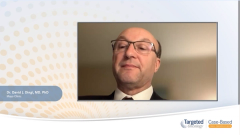
Immunologic Therapies in Multiple Myeloma: Expert Insights
An exploration of the landscape of immunologic therapies and alternative approaches for relapsed/refractory multiple myeloma, including bispecific antibodies, XPO1 inhibitors, venetoclax, and more.
Episodes in this series

Transcript:
David M. Dingli, MD, PhD: So I would classify the drugs that are available for a patient such as the one we’re discussing today into immunologic therapies vs other. And for the purpose of this discussion, I will not be spending time talking about CAR [chimeric antigen receptor] T cells much because this patient decided not to proceed with CAR T. Of course, many patients are eligible for CAR T, and that is the right drug approach for them that should be given. We have 2 big classes now of bispecific antibodies that are approved for patients with relapsed/refractory multiple myeloma.
We have teclistamab and elranatamab, which both target BCMA [B-cell maturation antigen]. And then we have talquetamab, which targets a different antigen known as GPRC5D, an orphan receptor. Apart from immunotherapies, one can consider additional agents, for example, selinexor, in combination with other agents, which is an XPO1 inhibitor. There is a subset of patients with myeloma who have the t(11;14) translocation. These patients overexpress BCL2, and their disease may be quite sensitive to venetoclax, although, of course, the drug is available off label only.
Other patients may respond to alkylating agents, drugs such as cyclophosphamide or bendamustine. And infrequently, patients may be treated with a…combination with other agents. So the spectrum of drugs that is available has been expanding. And one looks at what the patient has been treated with, the response rates that they’ve had, the morbidities that have developed, the complications that have developed, the result of the therapy. And then one can try to find a regimen that works best for this patient. One can also consider the possibility of revisiting regimens that the patient has received, if it has been quite some time since the patient was exposed to that class of drug, although the expectations for the response should be somewhat tempered.
BCMA, in short, is an exquisite target for multiple myeloma therapy because it is virtually expressed only in 2 types of cells, B cells and plasma cells. It is required for the survival and maturation of B cells, as this name implies. And almost all [patients with] multiple myeloma will have expression of BCMA on the surface of their plasma cells. So the high-level expression and the restricted expression to B cells and plasma cells make it an excellent target. Now, of course, therapy with the BCMA-targeted agent will kill not only the plasma cells but also B cells. So many of these patients end up being hypergammaglobulinemic, if they’re not already, as a result of their current or prior treatment. So many patients will need to be on immunoglobulin replacement therapy.
Transcript is AI-generated and edited for readability.









































